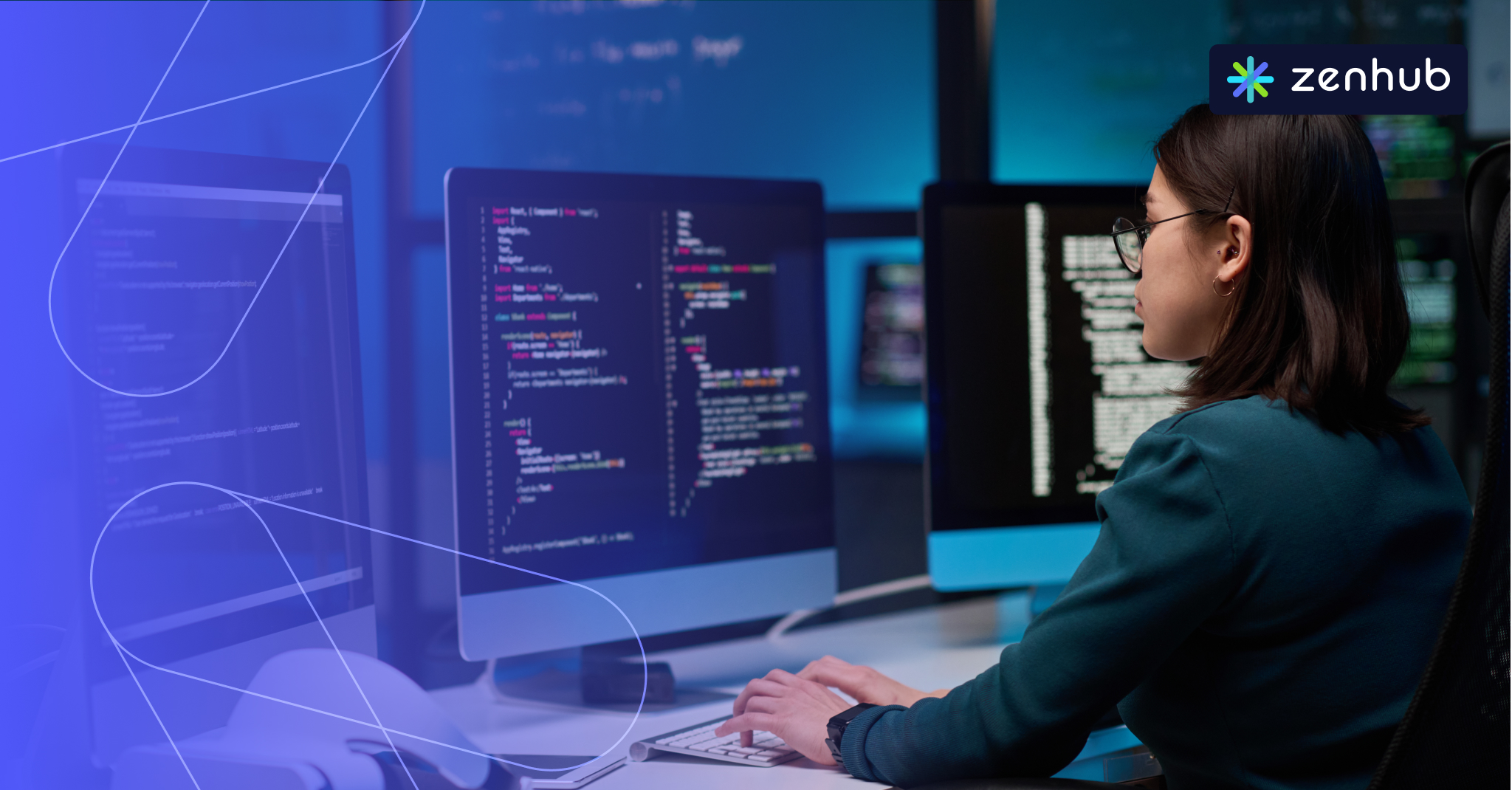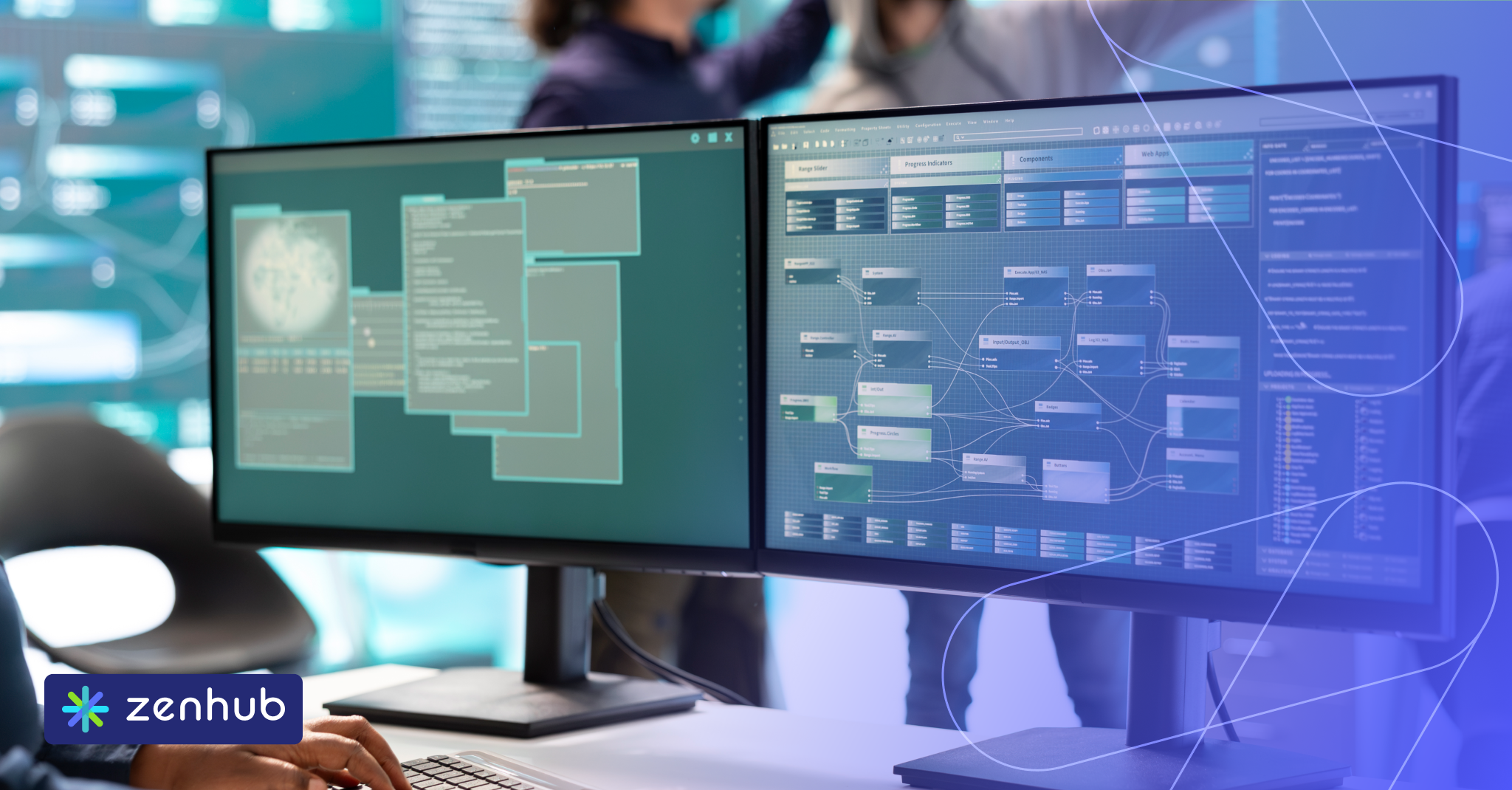Browse topics
Introduction
From code generation to testing, deployment, and maintenance, AI capabilities accelerate processes and enhance quality at every stage. For engineering leaders specifically, AI offers unprecedented opportunities to optimize team performance, improve decision-making, and deliver more consistent results.
Engineering leadership presents unique challenges that AI is particularly well-positioned to address. Leaders must balance technical excellence with operational efficiency, ensure consistent quality across distributed teams, and make data-driven decisions based on often fragmented information. Unlike tactical AI that might help individual developers write code, AI for engineering leadership focuses on augmenting strategic oversight, enhancing communication, and enabling predictive capabilities that prevent problems before they occur.
1. Why Engineering Leaders Should Consider Using AI
The strategic adoption of AI can fundamentally transform how engineering teams operate, collaborate, and deliver. Here's why engineering leaders should consider integrating AI into their processes.
1.1 Improve Consistency Across Teams
One of the most significant challenges for engineering leaders managing multiple teams is maintaining consistency in processes, documentation, and execution. AI tools offer powerful capabilities to standardize these elements across the organization.
Reducing Variability in Core Processes
Engineering teams often develop their approaches to reporting, sprint planning, and estimation, leading to inconsistencies that make it difficult to compare progress or allocate resources effectively. According to research from McKinsey, organizations with standardized processes see up to 30% higher productivity than those with varied approaches across teams. AI tools can analyze existing documentation and suggest standardized templates and processes that bring consistency while allowing for necessary team-specific customizations.
Zenhub's research with engineering teams found that inconsistent estimation was one of the top factors impacting predictable delivery, with 68% of teams reporting significant variability in how engineers estimate similar tasks. AI tools can analyze historical estimates and actual completion times to suggest more consistent estimation guidelines across teams.
Standardizing Documentation and Task Definitions
When each team uses different terminology or provides varying levels of detail in documentation and task descriptions, collaboration becomes difficult, and onboarding new team members takes longer. AI systems can analyze and suggest improvements to task descriptions, ensuring they contain necessary information such as clear acceptance criteria, dependencies, and implementation details.
A GitHub study on productivity factors found that teams with standardized documentation approaches could resolve bugs 28% faster and onboard new developers 35% more quickly than teams with inconsistent documentation practices. AI tools can automatically enforce documentation standards by suggesting improvements or generating typically missing sections.
1.2 Enhance Data Interpretation
Engineering leaders often have access to vast amounts of data but struggle to extract meaningful insights quickly enough to inform decisions.
Surfacing Hidden Insights
Traditional dashboards show what's happening but rarely explain why metrics are changing or how different factors are interconnected. AI can analyze complex data patterns across velocity metrics, burndown charts, and delivery patterns to identify meaningful correlations and potential root causes of issues.
Research for Zenhub Pulse shows that teams leveraging AI-enhanced analytics identified 42% more potential delivery risks than those using standard reporting tools. These AI systems can detect subtle patterns that might indicate problems, such as gradually decreasing velocity that coincides with increased context switching, before they become critical issues.
Improving Decision Quality
Engineering leaders must manually collect and analyze data from multiple dashboards and tools without AI assistance, which is time-consuming and prone to oversight. AI systems can continuously monitor data across systems, proactively alert leaders to significant changes or anomalies, and provide context-rich insights that consider historical patterns and team-specific factors.
According to DevOps Research and Assessment (DORA), elite-performing teams are 2.3 times more likely to use automated analytics to inform decision-making than lower-performing teams. This correlation suggests that enhanced data interpretation capabilities can significantly impact team performance.
1.3 Increase Operational Efficiency
Engineering leaders and managers often spend significant time on administrative tasks that could be automated, reducing their availability for higher-value activities like mentoring team members and strategic planning.
Automating Low-Impact Tasks
Various studies estimate that engineering managers spend 30-40% of their time on administrative tasks like writing status reports, organizing backlogs, and coordinating meetings. AI can automate much of this work, generating summaries of team activity, prioritizing backlog items based on strategic importance, and even scheduling meetings during optimal times based on team members' calendars and focus time.
LinearB research found that engineering teams using AI automation tools saved an average of 4.3 hours per engineer per week on administrative tasks, representing a potential productivity increase of over 10% for the entire engineering organization.
Focusing on People and Outcomes
By delegating routine administrative tasks to AI, engineering leaders can redirect their attention to developing team members, improving processes, and ensuring alignment with strategic goals. AI tools can also help identify which team members might benefit from additional support or mentoring by analyzing work patterns and comparing them to successful historical patterns.
A study from DevOps Research and Assessment found that teams whose leaders spent more time on mentoring and strategic activities showed 23% higher satisfaction scores and 18% lower turnover rates compared to teams where leaders were predominantly focused on administrative tasks.
1.4 Boost Strategic Visibility
Engineering leaders need to maintain high-level visibility across multiple projects and teams to identify risks early and allocate resources effectively.
Early Risk Detection
AI systems can analyze patterns across code commits, pull requests, issue creation rates, and comment sentiment to identify projects that may be at risk of delays or quality issues. These early warning systems can detect subtle indicators that might be missed in standard reporting, such as decreasing commit frequency, increasing code complexity, or changes in communication patterns within the team.
McKinsey research indicates that organizations using advanced analytics for risk detection identify potential project delays an average of 2.5 weeks earlier than those using traditional metrics, providing critical time to implement mitigating actions.
Identifying Contributors and Blockers
AI can analyze behavioral patterns in pull requests, code reviews, and issue interactions to identify both high-impact contributors and potential blockers to progress. These insights help leaders recognize team members who may need additional support or those whose contributions could be leveraged more effectively across the organization.
According to research from GitHub, teams that use analytics to identify and address workflow bottlenecks see a 35% improvement in pull request cycle time and a 28% reduction in time to resolve critical issues.
1.5 Improve Decision-Making with Predictive Intelligence
AI's predictive capabilities can help engineering leaders make more informed decisions about planning, resource allocation, and risk management.
Forecasting Delivery Timelines
Traditional project planning often relies on historical averages or subjective estimates, leading to consistent underestimation of completion times. AI systems can analyze past project data, considering factors like team composition, task complexity, and dependencies, to generate more accurate delivery forecasts.
A study by Forrester found that organizations using AI-enhanced forecasting reduced delivery estimation errors by 31% compared to traditional methods. This improved accuracy helps engineering leaders set realistic expectations with stakeholders and make better-informed decisions about project scope.
Estimating Team Capacity
AI tools can analyze historical performance data to provide more accurate estimates of team capacity for future sprints, accounting for variables like holidays, planned leave, onboarding of new team members, and the specific mix of work types. This helps prevent over-commitment and the resulting technical debt that often accumulates when teams are pushed beyond realistic capacity.
According to Zenhub's research, teams using AI-assisted capacity planning saw a 27% reduction in sprint overflow (work carried over to subsequent sprints) compared to teams using traditional planning methods.
2. What Engineering Leaders Need in an AI Tool
When evaluating AI tools for engineering leadership, several key capabilities should be considered to ensure they address the most critical challenges.
2.1 Clear Summaries of Work Being Done
Engineering leaders need concise, accurate overviews of work across multiple teams and projects without spending hours collecting and synthesizing information.
High-Level Work Overviews
Effective AI tools should automatically aggregate information from individual tasks and pull requests to provide meaningful summaries at the feature, project, or team level. These summaries should highlight progress toward objectives, identify potential risks, and provide context about any significant changes or decisions.
According to research from Stack Overflow, engineering leaders spend approximately 6.5 hours per week gathering information about team progress and creating reports for stakeholders. AI-generated summaries can reduce this time by up to 80%, allowing leaders to focus on addressing issues rather than just identifying them.
Automated Project and Sprint Summaries
AI tools should automatically generate up-to-date summaries of sprint or project status, including completed work, current focus areas, blockers, and upcoming priorities. These summaries should be available on demand and routinely generated at key milestones or schedule points.
LinearB found that teams using automated summary tools spent 62% less time in status meetings than teams relying on manual reporting, representing a potential saving of 2-3 hours per week per team member.
2.2 Insights into Team Performance
Engineering leaders need meaningful context around performance metrics to make informed decisions about process improvements and resource allocation.
Contextual Performance Metrics
Effective AI tools should present metrics like throughput, lead time, cycle time, and developer velocity within appropriate context, such as historical trends, team composition changes, or shifts in work type. This contextualization helps leaders distinguish between normal variations and significant changes that require attention.
Research from DevOps Research and Assessment (DORA) indicates that organizations that focus on a small set of contextualized metrics show better performance improvements than those tracking numerous metrics without context. The study found a 37% stronger correlation between focused metric tracking and performance improvement compared to broad metric tracking.
AI-Generated Commentary on Trends
Beyond just displaying metrics, AI tools should provide commentary that highlights important trends, potential causes, and recommended actions. This narrative layer helps engineering leaders quickly understand what the metrics mean and how they should respond.
A study by Forrester found that teams using AI-generated analytics commentary identified 42% more actionable insights from their metrics compared to teams using traditional dashboards with similar data.
2.3 Support for Consistent Project Execution
AI tools should help standardize project execution across teams, ensuring consistent quality and predictable outcomes.
Automated Story Creation and Estimation
AI systems can analyze project requirements and generate well-structured user stories with appropriate acceptance criteria and initial estimates based on historical data. This helps ensure consistency in how work is defined and sized across teams.
Research from Atlassian found that teams with standardized story formats and estimation approaches had 29% less variance in delivery time predictions compared to teams with inconsistent approaches.
AI-Assisted Sprint Planning and Review
AI tools can analyze historical performance, current team capacity, and strategic priorities to recommend balanced sprint plans that maximize value delivery while remaining achievable. During sprint reviews, AI can identify patterns across completed work to suggest process improvements or highlight successful approaches that could be replicated.
According to McKinsey research, teams using AI-assisted planning techniques consistently deliver 15-20% more story points per sprint after six months compared to teams using traditional planning approaches.
2.4 Natural Language Interactions
Engineering leaders need the ability to quickly get answers to specific questions without navigating complex dashboards or writing custom queries.
Question-Based Insights
AI tools should support natural language questions like "What's slowing down the mobile team?" or "How did our velocity change over the past 3 sprints?" These queries should return relevant, contextual information that directly addresses the question rather than requiring further analysis by the leader.
A study by Gartner found that natural language interfaces reduced the time required to extract specific insights from data by 78% compared to traditional dashboard navigation, with users reporting higher satisfaction and increased likelihood of data-driven decision making.
Contextual Understanding
Effective AI tools should understand the organizational context and repository structure, recognizing team names, project terminology, and the relationships between different components of the system. This contextual awareness ensures that responses to queries are relevant and accurate.
Microsoft research indicates that AI systems with domain-specific training provide responses that are rated 62% more relevant than general-purpose AI systems when answering questions about software development processes and metrics.
2.5 Integration with Existing Workflows
To be effective, AI tools must integrate seamlessly with the platforms and processes that engineering teams already use.
Platform Integration
AI tools should work directly within platforms like GitHub, Jira, or GitLab, providing insights and automation without requiring users to switch contexts or learn new interfaces. This integration should be bidirectional, allowing the AI to both consume data from and provide recommendations within these platforms.
According to research from Stack Overflow, tools that require context switching can reduce developer productivity by up to 30%, highlighting the importance of integrated solutions that operate within existing workflows.
Minimizing Additional Work
Effective AI tools should not require additional data entry, manual tagging, or maintenance activities beyond what teams would normally do as part of their development process. The AI should work with the artifacts and metadata that are already being generated through regular workflow activities.
Research from GitHub found that adoption rates for development tools drop by approximately 60% when they require additional manual steps compared to tools that work automatically with existing processes.
3. Categories of AI Tools for Engineering Leaders
3.1 AI-Powered Analytics Platforms
Analytics platforms with AI capabilities provide comprehensive visibility into engineering operations and performance.
Leading Examples
Platforms like Zenhub Pulse, Code Climate Velocity, LinearB, and Jellyfish aggregate data from various development tools to provide holistic analysis of engineering performance. These tools typically focus on metrics collection, visualization, and identifying trends or anomalies.
Key Use Cases
These platforms excel at analyzing performance metrics (including DORA metrics), optimizing resource allocation, identifying bottlenecks, and providing insights into engineering efficiency. They typically connect to multiple data sources to create a comprehensive view of development activities.
Primary Benefits
Engineering leaders benefit from real-time dashboards showing team health, predictive analytics identifying potential risks, and objective data for planning and resource allocation. These platforms often help quantify the impact of process changes or investments in technical improvements.
3.2 AI in Project Management Tools
Project management tools with AI capabilities help streamline planning, tracking, and reporting processes.
Leading Examples
Zenhub, ClickUp, and Jira (with AI plugins) integrate artificial intelligence directly into project management workflows. These tools focus on enhancing the core project management experience rather than just analyzing it.
Key Use Cases
AI-enhanced project management tools excel at automating issue triage, generating sprint summaries, grooming backlogs, recommending task assignments, and providing status updates. They often include features for automated documentation and reporting.
Primary Benefits
These tools promote workflow consistency across teams, significantly reduce manual effort in project management tasks, and improve cross-team alignment. By automating routine aspects of project management, they free engineering leaders to focus on higher-value activities.
3.3 AI in Code Review and Quality Tools
These tools focus specifically on improving code quality and streamlining the review process.
Leading Examples
GitHub Copilot, Codacy, and SonarQube with machine learning models assist developers and reviewers with code-specific insights. They analyze code patterns, potential issues, and improvement opportunities.
Key Use Cases
These tools provide automated code suggestions, advanced linting, performance analysis, security vulnerability detection, and identification of potential bugs or maintenance issues. Many also help optimize the review process by directing reviewer attention to high-risk changes.
Primary Benefits
Code quality tools help boost overall code quality without increasing review bottlenecks, identify potential issues before they reach production, and provide consistency in coding standards across teams. They often reduce the cognitive load on reviewers by highlighting the most important aspects of changes.
3.4 AI Knowledge Management and Search
These tools help teams capture, organize, and retrieve organizational knowledge more effectively.
Leading Examples
Platforms like Glean, Notion AI, and Confluence with AI capabilities enhance documentation and knowledge sharing. They focus on making information more accessible and useful.
Key Use Cases
AI knowledge tools excel at providing instant answers from documentation, improving onboarding materials, generating technical documentation, and creating connections between related information across repositories and systems.
Primary Benefits
These solutions provide faster access to institutional knowledge, reduce time spent searching for context or answers, and help preserve expertise even when team members change. They're particularly valuable for organizations with complex systems or high team turnover.
4. How Zenhub's AI Helps Engineering Leaders
4.1 AI-Powered Sprint Reviews
Zenhub's AI capabilities automatically generate comprehensive sprint recaps that save time and improve visibility.
Automated Comprehensive Recaps
Zenhub automatically creates detailed sprint reviews including completed issues, carryover items, blockers encountered, and thematic analysis of the work accomplished. These reviews go beyond simple lists to provide context and insights about sprint performance.
For example, rather than just listing completed tickets, Zenhub might note: "The team completed 12 of 15 planned stories (80%) representing 42 story points. Three high-priority bug fixes were added mid-sprint, which impacted the team's capacity to complete the planned feature work."
Time Savings and Improved Clarity
These automated reviews save significant time during retrospectives while providing clearer information to stakeholders. Teams can focus their retrospective discussions on improvements rather than simply recapping what happened.
Engineering leaders report saving 1-2 hours per team per sprint in retrospective preparation time while actually providing more detailed and consistent information about sprint outcomes.
4.2 AI-Generated Acceptance Criteria
Zenhub helps standardize requirements and reduce back-and-forth between product and engineering teams.
Structured Criteria Generation
Based on issue titles and descriptions, Zenhub's AI can draft structured acceptance criteria that follow team conventions and capture the necessary details for implementation. This helps ensure stories are implementation-ready and reduces ambiguity.
The AI learns from existing high-quality stories in your repositories, adapting to your team's specific patterns and requirements. Over time, it becomes increasingly accurate at predicting the acceptance criteria your team would define.
Standardization Benefits
This capability encourages uniformity in user stories across teams and reduces the iterative refinement process between product managers and engineers. By starting with AI-generated criteria, teams can focus on refinements rather than creating everything from scratch.
Teams using this feature report 30-40% reductions in story refinement time and fewer instances of work being sent back due to unclear or incomplete requirements.

%202.svg)













